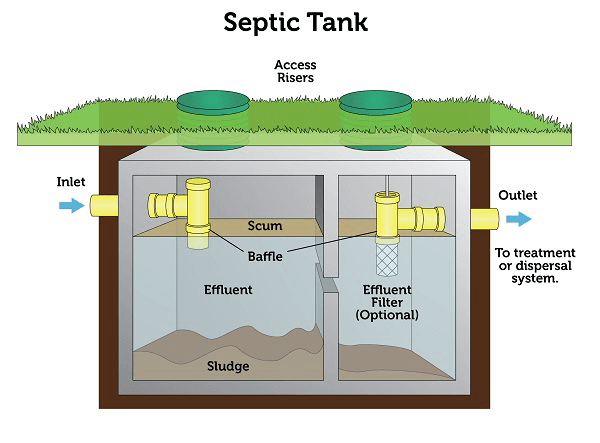
Your Septic System
Many homeowners are situated in locations where it is not feasible or practical to utilize a municipal sewage system. Instead, they rely on septic systems located on the property, adjacent to the house. If you are in this situation, and if you want to learn the basics of how septic systems work and what you must do to maintain it, then read on.
Your septic system disposes of and purifies the wastewater generated by your household. Wastewater contains liquids and solids from toilets, sinks, dishwashers, showers, baths, and laundry washing machines. Septic systems vary. Here, we’ll focus on a typical, commonly used type of system.
Your septic system has four components: a pipe, a septic tank, a drainfield, and soil. Wastewater, containing both liquids and solids, is generated in the house. It drains into a pipe where it flows to an underground septic tank. In the septic tank, the solids separate from the effluent (liquids). The solids remain in the septic tank, while the effluent passes out through another pipe and is deposited in a drainfield. The effluent then percolates into the surrounding soil where it undergoes filtration and purification. The now purified water may enter the groundwater, other bodies of water, or it may evaporate.
The Septic Tank
Septic tanks vary in design, size, and construction. A typical tank is made of concrete, but alternative construction materials include fiberglass and polyethylene. Capacity is measure in gallons, and common sizes are 1000, 1200, and 1500 gallons. A larger tank supports a larger household, improves the processing of wastewater, and requires pumping less frequently. A 1500-gallon septic tank measures around 12 feet in length, 6 ½ feet in width, and 5 feet in height.
Septic tanks are located close to the house and are completely underground, with the top of the tank one or two feet below the ground surface. One side of the tank has an inlet port, where the drain pipe from the house connects; and the opposite side of the tank has an outlet port, where another pipe connects to the drainfield. Septic tanks commonly have two compartments separated by an interior wall with an opening that allows flow from one compartment to the other compartment. Your tank may have one compartment, two compartments, or more; it varies.

The top of the tank has covered, removeable manholes—one for each compartment—to enable access for inspection and pumping. For easier access, each manhole may have a riser with a lid that extends from the tank top to the ground surface. Risers can be retrofitted to tanks that lack them. If the tank does not have risers, it is necessary to dig down to the manholes to obtain access for septic tank pumping.
Your septic tank receives all the wastewater from your house. It provides an environment where the solids can separate from the wastewater, resulting in three products: scum, sludge, and effluent. Substances lighter than water (oil, grease, fats) float to the top forming a scum later where microorganisms (bacteria) digest the floating solids. Soil, bones, unconsumed food particles, and other solids sink to the bottom forming a dense sludge layer where organic material is digested by bacteria and gas is produced. Effluent is the clarified wastewater produced when the scum floats to the top and the sludge settles on the bottom. It occupies a middle layer in the septic tank, between the sludge on the bottom and the scum on the top. It eventually exits the septic tank through the outlet port and then flows to the drainfield.
To achieve adequate separation of solids, the wastewater must remain in the septic tank at least 24 hours, but preferably two or three days. A larger septic tank facilitates longer retention of wastewater, while increasing daily wastewater flows shortens retention.
Newer systems often have an effluent filter that, if properly maintained, will prolong the life of the drainfield by filtering out suspended solids in the effluent and thereby limiting the passage of solids, grease, and oil into the drainfield. The filter is removeable and periodically should be removed and hosed off. A filter can be installed (retrofitted) in older tanks that lack a filter.
Microorganisms consume the organic solids deposited in the septic tank. The decomposition by-products are soluble compounds that are carried away in the liquid effluent, and various gases that are vented out via the inlet pipe that connects with the house plumbing air vent system. Although decomposition slowly reduces the volume of solids in the septic tank, eventually the sludge and scum accumulate and occupy more and more of the septic tank’s volume, leaving less space for the effluent. As new wastewater enters the septic tank, effluent must exit the tank. As less and less space is available, the time that wastewater is retained by the tank decreases, and the separation of solids may become compromised.
At some point, the accumulated solids must be pumped out of the tank. Otherwise, wastewater will not remain in the tank long enough for adequate separation of solids, and solids may then flow out of the tank with the effluent into the drainfield. The result can be clogged pipes and gravel in the drainfield, and the surfacing of effluent or system backup into house drains.
Failure to pump out the septic tank is one of the most common causes of septic system failure. Replacing a failed drainfield is an expensive proposition.
The Drainfield
Wastewater undergoes primary treatment in the septic tank. The partially treated wastewater is pushed along, as effluent, into the drainfield for further treatment every time new wastewater enters the tank. The drainfield provides final purification and disposal.
A typical drainfield consists of shallow, gravel-filled trenches with a perforated pipe near the top of the gravel. Effluent flows from the tank into the perforated pipes and is then distributed into the gravel in the drainfield trenches. From there, it seeps into the soil where the main purification occurs through filtration and the activity of the biological mat (also known as the biomat). This process requires suitable soil.

The biomat is composed of microorganisms and their by-products. It lines the trenches and acts on the organic matter from the septic tank effluent, filtering out viruses and pathogenic bacteria. The purified liquid eventually evaporates, is absorbed by plants, or percolates into the groundwater.
Typical pollutants in household wastewater are nitrogen, phosphorus, and disease-causing bacteria and viruses. A properly working septic system will remove most of these pollutants. Inadequately maintained septic systems can be a cause of groundwater contamination, resulting in contamination of drinking water wells and leading to diseases and infections in people and animals.
The functioning of the biomat requires a balance between two opposing tendencies. The anaerobic bacteria in the trench feed on the organic material in the wastewater, causing the biomat to grow thicker and less permeable, while the aerobic bacteria on the soil side of the biomat feed on the biomat, thereby decreasing its thickness and increasing its permeability.
A drainfield may perform indefinitely if properly designed and maintained. Failure to regularly pump out the septic tank can result in an excess of organic material which may adversely affect the biomat, leading to backflow into the septic tank and sometimes into the house.
During use, sludge and floating scum will build up, reducing the effective capacity of the tank. When wastes pass through the tank too quickly, solids eventually plug the pipes in the drainfield, and the microorganisms needed to digest the solids are impaired. As a result, untreated effluent may begin surfacing on the ground or sewage may back up into house drains. When this happens, a new drainfield is needed. Expensive!
Septic Tank Pumping
When properly designed, constructed, and maintained, septic systems effectively reduce or eliminate most human health or environmental threats posed by pollutants in household waste. Your system will need pumping, generally every 3 to 5 years depending on how many people live in the house and the size of the system.
Septic tanks are pumped by a licensed pumper using a vacuum tank trunk with large diameter hoses. Everything is pumped out—both solids and liquids. When the septic tank has two chambers (which is common), both chambers should be pumped out. In addition, the filter should be cleaned. The waste that is removed from the tank, known as septage, is then transported to a facility where it can be processed.
Maintaining your septic system gives truth to the old adage, an ounce of prevention is worth a pound of cure.
Illustrations on this page are from Types of Septic Systems, by the United States Environmental Protection Agency. Link
BROWSE OUR WEBSITE
CONTACT INFORMATION
Phone: 530-556-9898
Email: office@wsspi.com
Address: 100 Shultz Vineyard Road, Shingle Springs, CA 95682
Certified Septic Inspectors
Serving: El Dorado & Amador Counties
BUSINESS HOURS
- Mon - Fri
- -
- Sat - Sun
- Closed
and by appointment
